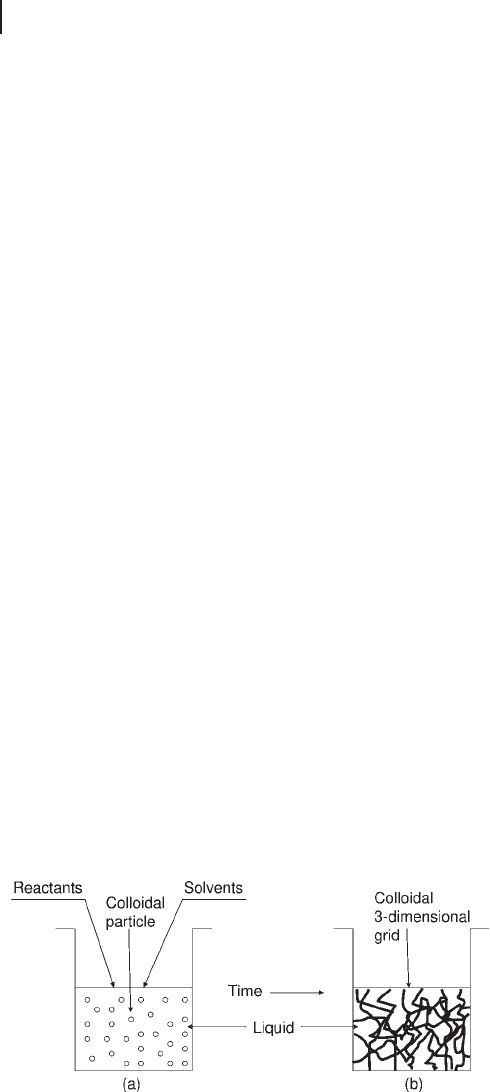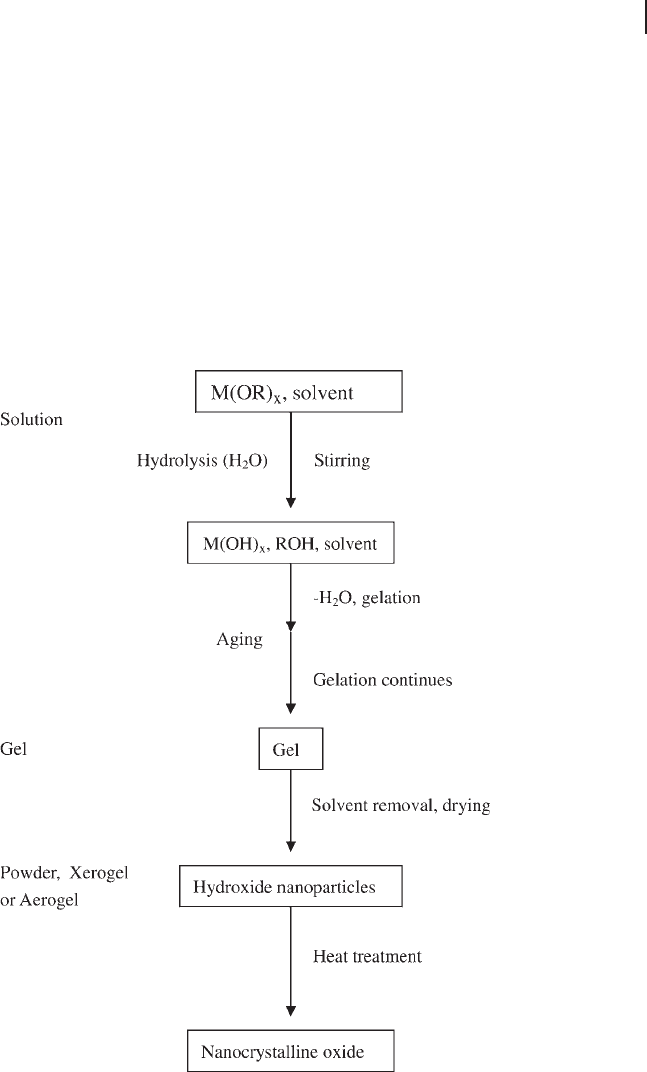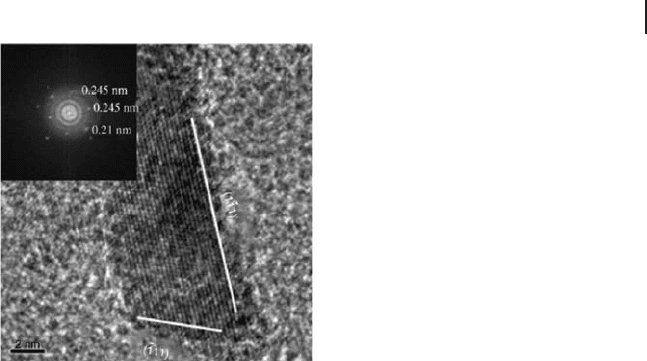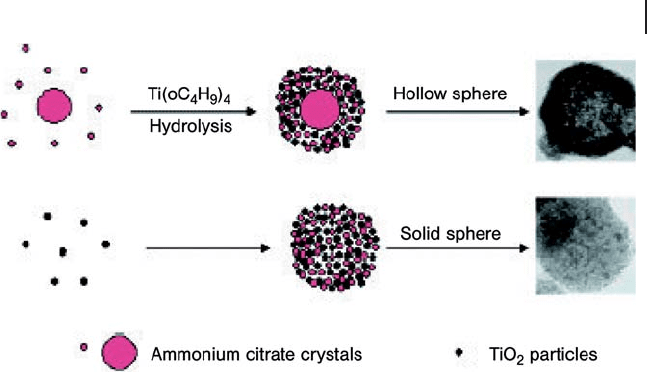Jackson S.D., Hargreaves J.S.J. Metal Oxide Catalysis
Подождите немного. Документ загружается.


16.3 Synthesis 619
16.2.4
Redox Property of Metal Oxides
In some catalytic reactions, metal oxides often undergo reduction and re - oxidation
simultaneously by loss and gain of surface lattice oxygen to and from the gas
phase. This phenomenon is called redox catalysis. The redox property as well as
the acidic and basic nature are the most important properties of metal oxide
catalysis. It is well known that some simple metal oxides such as V
2
O
5
, CoO
2
, NiO,
MnO
2
, CeO
2
, MgO and some mixed metal oxides have redox properties. Mars and
van Krevelen fi rst proposed a redox mechanism to describe oxidation of com-
pounds over oxide catalysts [29] . The Mars – van Krevelen mechanism ( MvK ) is now
commonly accepted. When an adsorbate is oxidized at the surface, the oxidant is
often a surface lattice oxygen atom, thus creating a surface oxygen vacancy. Surface
oxygen vacancies are proposed to participate in many chemical reactions catalyzed
by metal oxides. Vacancies also bind adsorbates more strongly than normal oxide
sites and assist in their dissociation. The redox property of a metal oxide catalyst
can be characterized by using the techniques of temperature - programmed
reduction/temperature - programmed oxidation ( TPR/TPO ).
16.3
Synthesis
The development of synthetic methods is one of the fundamental aspects to the
understanding and development of nano - scale materials. The novel properties and
numerous applications of nano - scale materials have encouraged many researchers
to invent and explore preparation methods that allow control over such parameters
as particle size, shape, size distributions and composition. While considerable
progress has taken place, one of the major challenges is the development of a
“ synthetic toolbox ” which would afford access to size and shape control of struc-
tures on the nano - scale and conversely allow scientists to study the effects these
parameters impart to the chemical and physical properties of the nanoparticles.
The two principal approaches to the preparation of nano - scale materials are
“ bottom - up ” and “ top - down ” . While “ top - down ” preparations involve approaching
the nano - scale by breaking down larger starting materials, the “ bottom - up ” prepa-
ration methods are of primary interest to chemists and materials scientists because
the fundamental building blocks are atoms or molecules, and these methods will
be the focus of this chapter. Among the most sought after goals of synthetic chem-
ists is gaining control over the way these fundamental building blocks come
together and form particles. Interest in “ bottom - up ” approaches to nano - scale
oxides and other materials is clearly indicated by the number of reports and
reviews on this subject [30 – 46] . There are, of course, numerous “ bottom - up ”
approaches to the preparation of nano - scale materials, and metal oxides are no
exception. Gas – solid (wet chemical) and liquid – solid (physical) transformations

620 16 Properties, Synthesis and Applications of Highly Dispersed Metal Oxide Catalysts
are two different approaches to synthesizing nanomaterials by “ bottom - up ” prepa-
ration methods. Several physical aerosol methods have been reported for the
synthesis of nano - size particles of oxide materials including gas condensation
techniques [47 – 53] , spray pyrolysis [51, 54 – 60] , thermochemical decomposition of
metal – organic precursors in fl ame reactors [53, 61 – 63] and other aerosol processes
named after the energy sources applied to provide the high temperatures during
gas – particle conversion. The sol – gel process is by far the most common and widely
used “ bottom - up ” wet chemical method for the preparation of nano - scale oxides.
Other wet chemistry methods including novel micro - emulsion techniques, oxida-
tion of metal colloids and precipitation from solutions have also been used.
The methods of sample preparation are critical as they determine the morphol-
ogy of the resulting material [64] . For example, burning Mg in O
2
(MgO smoke)
yields 40 – 80 nm cubes and hexagonal plates, while thermal decomposition of
Mg(OH)
2
, MgCO
3
and especially Mg(NO
3
)
2
yields irregular shapes often exhibiting
hexagonal platelets. Surface areas can range from 10 m
2
g
− 1
(MgO smoke) to
250 m
2
g
− 1
for Mg(OH)
2
thermal decomposition, but surface areas of about
150 m
2
g
− 1
are typical. In the case of calcium oxide, surface areas can range from
1 to 100 m
2
g
− 1
when prepared by analogous methods, but about 50 m
2
g
− 1
is typical.
In the following discussion, the most common methods for the synthesis of metal
oxides will be the focus.
16.3.1
Sol – Gel Technique
Sol – gel processing describes a type of solid materials synthesis procedure, per-
formed in a liquid and at low temperature (typically T < 100 ° C). The development
of sol – gel techniques has long been known for preparations of metal oxides and
has been described many times [30 – 38, 40 – 46, 65] . The process is typically used
to prepare metal oxides via the hydrolysis of reactive precursors, usually alkoxides
in an alcoholic solution, resulting in the corresponding hydroxide. It is usually
easy to maintain such hydroxide in a dispersed state in the solvent. Condensation
of the hydroxide molecules with loss of water leads to the formation of a network.
When hydroxide species undergo polymerization by condensation of the hydroxy
Figure 16.2 The sol – gel process: (a) sol, (b) gel.

16.3 Synthesis 621
Figure 16.3 A fl ow chart of a typical sol – gel process for preparing
nano - scale metal oxide powder.
network, gelation is achieved and a dense porous gel is obtained. The gel is a
polymer with a three - dimensional skeleton surrounding interconnected pores,
and the gels that are obtained are termed colloidal gels (Figure 16.2 b). Removal
of the solvents and appropriate drying of the gel are important steps that result
in an ultra - fi ne powder of the metal hydroxide. Heat treatment of the hydroxide
is a fi nal step that leads to the corresponding ultra - fi ne powder of the metal oxide.
Depending upon the heat treatment procedure, the fi nal product may be in the
form of a nano - scale powder, bulk material or oxygen - defi cient metal oxide. A
fl ow chart of typical sol – gel processing of nano - scale metal oxides is shown in
Figure 16.3 .
The chemical and physical properties of the fi nal product are primarily deter-
mined by the hydrolysis and drying steps.

622 16 Properties, Synthesis and Applications of Highly Dispersed Metal Oxide Catalysts
16.3.1.1 Hydrolysis and Condensation of Metal Alkoxides
The initial species used in sol – gel processing are metal alkoxides (M(OR)
y
). Hydro-
lysis of metal alkoxides involves nucleophilic reactions with water as follows:
M OR H O M OR OH ROH
()
+↔
()()
+
−yyx
xx
2
The mechanism of this reaction involves the addition of a negatively charged
HO
δ −
group to the positively charged metal center (M
δ +
). The positively charged
proton is then transferred to an alkoxy group followed by the removal of ROH.
HO
M + ROH
O
¦Ä-
+ M
¦Ä+
H
H
O
¦Ä-
R
O
H
+
H
O
¦Ä-
R
M
HO
HO
R
M
H
HO
M + ROH
Condensation occurs when the hydroxide molecules bind together as they
release water molecules and a gel/network of the hydroxide is obtained as shown
below:
MOH
MOMOH
M
H++
2
O
The rates at which hydrolysis and condensation take place are important param-
eters that affect the properties of the fi nal product, as slower and more controlled
hydrolysis typically leads to smaller particle sizes and more unique properties.
Hydrolysis and condensation rates have been found to depend on the electronega-
tivity of the metal atom, the alkoxy group, the solvent system and the molecular
structure of the metal alkoxide. Those metals with higher electronegativities
undergo hydrolysis more slowly than those with lower electronegativities. For
example, the hydrolysis rate of Ti(OEt)
4
is about fi ve orders of magnitude greater
than that of Si(OEt)
4
. Hence, the gelation times of silicon alkoxides are much
longer (on the order of days) than those of titanium alkoxides (few seconds or
minutes) [55] . The sensitivity of metal alkoxides toward hydrolysis decreases as the
OR group size increases, with smaller OR groups leading to higher reactivity of
the corresponding alkoxide toward water, in some cases resulting in uncontrolled
precipitation of the hydroxide.
The choice of solvents in sol – gel processes is very important because alcohol
interchange reactions are possible. As an example, when silica gel was prepared
from Si(OMe)
4
and heated to 600 ° C the surface area was 300 m
2
g
− 1
with a mean
pore diameter of 29 Å when ethanol was used as a solvent. However, when metha-
nol was used, the surface area dropped to 170 m
2
g
− 1
and the mean pore diameter
increased to 36 Å [32] . The rate of hydrolysis also becomes slower as the coordina-
tion number around the metal center in the alkoxide increases. Therefore, alkox-
ides that tend to form oligomers usually show slower rates of hydrolysis and,

16.3 Synthesis 623
hence, are easier to control and handle. n - Butoxide (O - n - Bu) is often preferred as
a precursor to different oxides including TiO
2
and Al
2
O
3
, because it is the largest
alkoxy group that does not prevent oligomerization [33] .
Because most metal alkoxides are highly reactive toward water, careful handling
in dry atmospheres is required to avoid rapid hydrolysis and uncontrolled precipi-
tation. For alkoxides that have low rates of hydrolysis, acid or base catalysts can
be used to enhance the process. The relatively negative alkoxides are protonated
by acids, creating a better leaving group and eliminating the need for proton
transfer in the transition state. Alternatively, bases provide better nucleophiles
(OH
−
) for hydrolysis; however, deprotonation of metal hydroxide groups enhances
their condensation rates. In the case of highly reactive compounds, controlling the
hydrolysis ratio may necessitate the use of non - aqueous solvents, where hydrolysis
is controlled by strict control of water in the system rather than by acids or bases.
Klabunde and coworkers have demonstrated the effectiveness of this approach in
the preparation of gels from Mg(OEt)
2
in methanol and methanol – toluene solvents
[66] .
16.3.1.2 Solvent Removal and Drying
Developments in the areas of solvent removal and drying have further facilitated
the production of nano - scale metal oxides with novel properties. When drying is
achieved by solvent evaporation at ambient pressure with moderate shrinkage, the
gel network shrinks as a result of capillary pressure, and the hydroxide product
obtained is referred to as xerogel. However, if supercritical drying is applied using
a high - pressure autoclave reactor at temperatures higher than the critical tempera-
tures of solvents, less shrinkage of the gel network occurs, as there is no capillary
pressure and no liquid – vapor interface, which allows the pore structure to remain
largely intact by avoiding the pore collapse phenomenon. In practice, supercritical
drying consists of heating the wet gel in a closed container, so that the pressure
and temperature exceeds the critical temperature, T
c
, and critical pressure, P
c
, of
the liquid entrapped in the pores inside the gel. The critical conditions are very
different depending on the fl uid which impregnates the wet gel. A few values are
given in Table 16.1 [67] . The hydroxide product obtained in this manner, which is
the traditional drying technique, is referred to as an aerogel and is the origin of
the label “ aerogel ” . Aerogel powders usually demonstrate higher porosities and
larger surface areas than analogous xerogel powders. Aerogel processing has been
very useful in producing highly divided powders of different metal oxides [28, 68,
69] (Figures 16.4 – 16.6 ).
Sol – gel processes have several advantages over other techniques for the synthe-
sis of nano - scale metal oxides. Because the process begins with a relatively homo-
geneous mixture, the resulting product is generally a uniform ultra - fi ne porous
powder. Sol – gel processing also has the advantage that it can be scaled up to
accommodate industrial - scale production.
Numerous metal oxide nanoparticles have been produced by making some
modifi cations to the traditional AP method. One modifi cation involved the
addition of large amounts of aromatic hydrocarbons to the alcohol – methoxide

624 16 Properties, Synthesis and Applications of Highly Dispersed Metal Oxide Catalysts
Table 16.1 Critical point parameters of common fl uids.
Fluid Formula T
c
( ° C) P
c
(MPa)
water H
2
O 374.1 22.04
carbon dioxide CO
2
31.0 7.37
Freon 116 (CF
3
)
2
19.7 2.97
acetone (CH
3
)
2
O 235.0 4.66
nitrous oxide N
2
O 36.4 7.24
methanol CH
3
OH 239.4 8.09
ethanol C
2
H
5
OH 243.0 6.3
Figure 16.4 TEM micrograph of the
nanostructure of CP - MgO. Note the absence
of porosity and that all of the nanocrystals
have agglomerated (from [68] ).
Figure 16.5 TEM micrograph of the
nanostructure of AP - MgO (supercritical
solvent removal). Porosity is formed by the
interconnected cubic nanocrystals of MgO
(from [28] ).

16.3 Synthesis 625
solutions before hydrolysis and alcogel formation. This was done in order to
further reduce the surface tension of the solvent mix and to facilitate solvent
removal during the alcogel – aerogel transformation [30, 64, 70] . The resulting
nanoparticles exhibited higher surface areas, smaller crystallite sizes and more
porosity for samples of MgO, CaO, TiO
2
and ZrO
2
[71, 72] .
Nano - structured MgO and CaO have been reported to be extremely effective for
the destructive adsorption of numerous environmental toxins and several chemi-
cal warfare agents. Figure 16.7 outlines briefl y how nano - crystalline and micro -
crystalline MgO and CaO were prepared. For nano - crystalline MgO (AP - MgO)
surface areas ranged from 250 to 500 m
2
g
− 1
and for AP - CaO 100 – 160 m
2
g
− 1
. For
CP micro - crystalline MgO and CaO, the surface areas are 130 – 250 and 50 –
100 m
2
g
− 1
, respectively, whereas commercially available MgO and CaO had the
lowest surface areas. Richards and coworkers have reported a simple method for
preparing a sheet - like MgO with a thickness of less than 10 nm and, more interest-
ingly, exhibiting the highly ionic (111) facet as the major surface of the “ nanosheet ” .
In this system, a mixture of water and methanol was added slowly to hydrolyze a
magnesium methoxide/benzyl alcohol solution to produce the nanosheets. Theo-
retical studies suggest that water plays an important role as chemisorption of water
forms a hydroxyl surface which stabilizes the otherwise unstable (111) surface of
MgO [69] .
Mesoporous and spherical TiO
2
materials are interesting candidates for applica-
tions in catalysis, biomaterials, microelectronics, optoelectronics and photonics.
Zhang and coworkers have put forward a new method to synthesize mesoporous
TiO
2
as well as hollow spheres, using titanium butoxide, ethanol, citric acid, water
and ammonia [73] . The mesoporous solid and hollow spheres were formed with
the same reactants but adding them in a different order. The TiO
2
possessed a
mesoporous structure with the particle diameters of 200 – 300 nm for solid spheres
and 200 – 500 nm for hollow spheres. The average pore sizes and BET surface areas
of the mesoporous TiO
2
solid and hollow spheres are 6.8 and 7.0 nm and 162
Figure 16.6 TEM micrograph of MgO(111)
(supercritical solvent removal). Here the MgO
nanoplates possess the (111) surface on the
edges (from [69] ).

626 16 Properties, Synthesis and Applications of Highly Dispersed Metal Oxide Catalysts
and 90 m
2
g
− 1
, respectively. Optical adsorption studies showed that the TiO
2
solid
and hollow spheres possess a direct band gap structure with the optical band gap
of 3.68 and 3.75 eV, respectively. The advantage of this route is that it does not use
surfactants or templates, as is more usual for synthesizing mesoporous materials.
In the proposed preparation mechanism (Figure 16.8 ), ammonium citrate forms
and plays a key role in the formation of the mesoporous solid [73] . The formation
of solid mesoporous TiO
2
or of hollow spheres was highly dependent on the extent
of TiO
2
condensation at the onset of ammonium citrate crystal growth. That is,
mesoporous solid spheres form when the TiO
2
condensation process takes place
simultaneously with the formation of ammonium citrate crystals; mesoporous
hollow spheres are produced when the nucleation and growth of ammonium
citrate crystals occurs before the TiO
2
condensation process.
The chemistry of transition metals differs from those systems previously dis-
cussed, and only a few transition metals exhibit metal – alkoxide chemistry ame-
nable to sol – gel synthesis. Cerda and coworkers prepared BaSnO
3
[74] by calcining
a gel formed between Ba(OH)
2
and K
2
SnO
3
at pH ≈ 11. The material possessed a
particle size of 200 – 500 nm and contained BaCO
3
as an impurity, which can be
eliminated by high temperature calcination. O ’ Brien and coworkers [75] synthe-
Figure 16.7 Schematic of the preparative scheme for nano -
crystalline MgO (CaO) labeled AP - MgO (CaO) and micro -
crystalline MgO (CaO) labeled CP - MgO (CaO).

16.3 Synthesis 627
sized samples of monodisperse nanoparticles of barium titanate with diameters
ranging from 6 to 12 nm by the sol – gel method. The technique was extended by
Meron and coworkers [76] to the synthesis of colloidal cobalt ferrite nanocrystals.
This synthesis involved the single - stage high - temperature hydrolysis of metal –
alkoxide precursors to obtain crystalline, uniform, organically coated nanoparti-
cles, which were well dispersed in an organic solvent. They were also able to form
Langmuir – Blodgett fi lms consisting of a close packed nanocrystal monolayer. The
structural and magnetic properties of these nanocrystals were similar to those of
bulk Fe
3
O
4
with a very high coercivity at low temperatures. Other aerogel oxides,
such as V
2
O
5
[77, 78] MoO
3
[78] and MnO
2
[79, 80] , have also been prepared.
Nanocomposites of RuO
2
– TiO
2
[81] are of particular interest because of their
supercapacitor properties.
16.3.2
Co - precipitation Methods
One of the conventional syntheses to prepare nanoparticles is the precipitation of
sparingly soluble products from aqueous solutions, followed by thermal decomposi-
tion of those products to oxides [82 – 84] . This process involves dissolving a salt pre-
cursor, usually a chloride, oxychloride or nitrate, such as AlCl
3
to make Al
2
O
3
,
Y(NO
3
)
3
to make Y
2
O
3
and ZrOCl
2
to make ZrO
2
. The corresponding metal hydrox-
ides are usually formed and precipitated in water by the addition of a basic solution
such as sodium hydroxide or ammonia solution. The resulting chloride or nitrate
salts, such as NaCl or NH
4
Cl, are then washed away and the hydroxide is calcined
after fi ltration and washing to obtain the fi nal oxide powder. This method is useful
in preparing composites of different oxides by co - precipitation of the corresponding
Figure 16.8 Schematic illustration of the formation
mechanisms for mesoporous TiO
2
hollow and solid spheres
(from [73] ).

628 16 Properties, Synthesis and Applications of Highly Dispersed Metal Oxide Catalysts
hydroxides in the same solution. One of the disadvantages of this method is the
diffi culty in controlling the particle sizes and size distribution. Very often, fast
(uncontrolled) precipitation takes place, resulting in large particles. In order to
overcome this shortcoming, some new co - precipitation methods have developed,
such as sonochemical co - precipitation and microwave - assisted co - precipitation.
16.3.2.1 Co - precipitation from Aqueous Solution at Low Temperature
The products of co - precipitation reactions are usually amorphous at or near room
temperature. It is diffi cult to determine experimentally whether the as - prepared
precursor is a single - phase solid solution or a multi - phase, nearly homogeneous
mixture of the constituent metal hydroxides, carbonates and oxides that react to
form a single phase mixed metal oxide when heated.
Many nano - particulate metal oxides are prepared by calcining hydroxide co -
precipitation products. As an example, the zirconia system is highlighted here
because of its interesting properties and applications. Zirconia has very interesting
properties as an acid – base catalyst, as a promoter for other catalysts and as an inert
support material [85, 86] . Sulfated ZrO
2
is of great interest on account of its high
activity as a solid acid catalyst in alkylation, while ZrO
2
has also been found to act
as a photocatalyst, owing to its n - type semiconductor nature.
The typical preparation consists of the calcination of a hydroxylated gel prepared
by hydrolysis of zirconium salts in various media [72, 87 – 94] . Amorphous zirconia
undergoes crystallization at around 450 ° C and hence its surface area decreases
dramatically at that temperature. At room temperature the stable crystalline phase
of zirconia is monoclinic while the tetragonal phase forms upon heating to 1100 –
1200 ° C For several applications, it is desirable to have the tetragonal phase with
a high surface area. However, preparation protocols are needed to obtain the
tetragonal phase at lower temperatures. Many researchers have tried to maintain
the high surface area ( HSA ) of zirconia by several means. Usually the ZrO
2
is
mixed with CaO, MgO, Y
2
O
3
, Cr
2
O
3
, or La
2
O
3
for stabilization of the tetragonal
phase at low temperature [95] . Bedilo and Klabunde [92, 93] have prepared HSA
sulfated zirconia by a supercritical drying technique and found that the resulting
material was active towards alkane isomerization reactions [92, 94] . Recently,
Chane - Ching and coworkers [96] reported a general method to prepare HSA
materials through the self - assembly of functionalized nanoparticles. This process
involves functionalizing the oxide nanoparticles with bifunctional organic anchors
such as aminocaproic acid and taurine. After the addition of a copolymer surfac-
tant, the functionalized nanoparticles will slowly self - assemble on the copolymer
chain through a second anchor site. Using this approach the authors prepared
several metal oxides, including CeO
2
, ZrO
2
and CeO
2
– Al(OH)
3
composites. The
method yielded ZrO
2
of surface area 180 m
2
g
− 1
after calcining at 500 ° C, 125 m
2
g
− 1
for CeO
2
and 180 m
2
g
− 1
for CeO
2
– Al(OH)
3
composites.
Table 16.2 [97 – 100] shows the literature data for zirconia obtained by different
processes and the resulting surface area obtained at different calcination tempera-
tures. Richards and coworkers [101] obtained stable ZrO
2
by the cetyltrimethylam-
monium chloride stabilization route and the data indicate that digesting the
